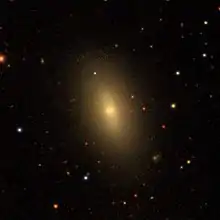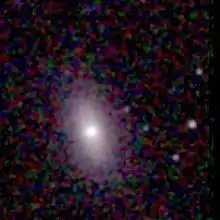NGC 16
NGC 16 is a lenticular galaxy located in the Pegasus constellation. It was discovered on September the 8th 1784 by William Herschel.[3]
| NGC 16 | |
|---|---|
 NGC 16 (Sloan Digital Sky Survey) | |
| Observation data (J 2000.0 epoch) | |
| Constellation | Pegasus |
| Right ascension | 00h 09m 04.3s |
| Declination | +27° 43′ 45″ |
| Redshift | 0.010340[1] |
| Helio radial velocity | 3100 ± 17 km/s[1] |
| Apparent magnitude (V) | 13.0[1] |
| Absolute magnitude (V) | -20.62[2] |
| Characteristics | |
| Type | SAB0− |
| Apparent size (V) | 1.8' x 1.0'[1] |
| Other designations | |
| UGC 80, PGC 660. | |
In the Webb Society Deep-Sky Observer's Handbook, [4] the visual appearance of NGC 16 is described as follows:
Round, with a slightly brighter centre; the outer nebulosity is of uniform surface brightness.

NGC 16 in near-infrared
References
- "NASA/IPAC Extragalactic Database". Results for NGC 0016. Retrieved 2010-05-05.
- https://in-the-sky.org/data/object.php?id=NGC16
- Seligman, Courtney. "NGC 16". Celestial Atlas. Retrieved 7 November 2018.
- Jones, K. G. (1981). Webb Society Deep-Sky Observer's Handbook. Enslow Publishers. ISBN 978-0-89490-134-8.
External links
 Media related to NGC 16 at Wikimedia Commons
Media related to NGC 16 at Wikimedia Commons- NGC 16 on WikiSky: DSS2, SDSS, GALEX, IRAS, Hydrogen α, X-Ray, Astrophoto, Sky Map, Articles and images
This article is issued from Wikipedia. The text is licensed under Creative Commons - Attribution - Sharealike. Additional terms may apply for the media files.